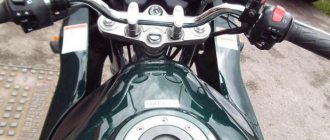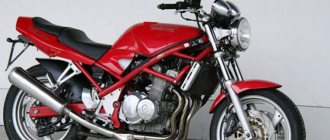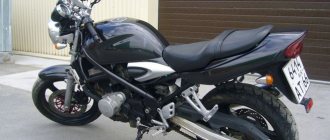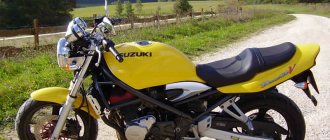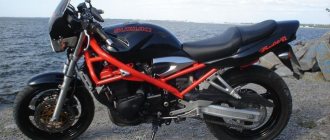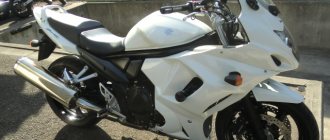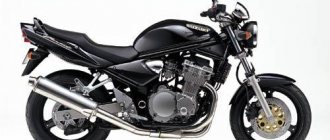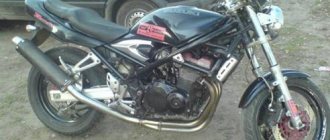GSF 750 Bandit
— a model of a
Suzuki
.
The Suzuki GSF 750 Bandit naked model appeared in 1996 and was produced until 1999. The motorcycle was aimed at the Japanese market and was not officially exported to other countries. The model was based on the air-oil engine from the sports model Suzuki GSX-R750 (1989), the frame and chassis from the Suzuki GSF 600 Bandit, and the subframe, dashboard and exhaust from the Suzuki GSF 1200 Bandit. The 6-speed gearbox is similar to the gearbox on the Suzuki GSF 600 Bandit.
An interesting point is also the fact that the Suzuki GSF750 model was not labeled “Bandit”, although most fans of the series attribute it to this class, calling it Suzuki GSF750 Bandit.
As mentioned above, the motorcycle was based on the engine from the sports version of the Suzuki GSX-R750 model of 1989, which was significantly retuned and derated. As a result, the engine began to produce 77 hp. power and 64 Nm of torque. The engine has smooth traction at low and medium speeds, and shows maximum performance at 7000-9000 rpm.
The features of the Suzuki GSF750 Bandit include a classic steel tubular frame, a 6-speed gearbox, simple suspension in the form of a conventional telescopic fork at the front and a monoshock absorber at the rear, a 19-liter fuel tank and a 224 kg curb weight.
The Suzuki GSF 750 model existed on the market until 1999, after which it disappeared from sales. The model was replaced in 1998 by the “classic” Suzuki GSX750 (Inazuma), which was practically not in demand in Japan, so most of them were sold on foreign markets.
Years of sales
The Suzuki GSF 750 model appeared in 1996 and was produced until 1999.
The motorcycle was produced until 1998 and sold until the summer of 1999 . There were no official deliveries to other countries, but thanks to “gray” sales it became famous both in Russia and around the world.
In 1998, the concern launched the Suzuki GSX750 Inazuma . It becomes the official successor to the model in European markets. For Japan they offer the younger sister of the Suzuki GSX400 Inazuma.
Repair and tuning
Owners of the GSX-R 750 will be pleased with the fact that there are enough spare parts for their steel horses. There are both original Suzuki parts on sale and a lot of analogues, which are often not inferior in quality to components sold by official dealers.
Repair
Servicing old Jixers yourself is not difficult. In recent generations, Suzuki engineers have significantly improved the design, at the same time making it more complex, so for a number of issues you will have to contact authorized dealers. But this trend affects all modern motorcycles and cars.
Tuning
Probably no sportbike in the world has as much tuning as the Suzuki GSX-R750. This is doubly true for previous generations, which were notorious for insufficiently effective brakes with sluggish feedback. Therefore, many sportbikes of this model on the secondary market are sold in a form modified by previous owners, with reinforced brake hoses, new brake cylinders and calipers.
Specifications
The motorcycle's power unit is an air-oil-cooled in-line four with a capacity of 77 horsepower.
The expected solution for a hybrid of two models was that the new motorcycle could get its engine from one of the previously released bikes.
Therefore, the engineers did not invent anything, but took the engine from the GSX-R750 sports model. It was retuned, the power was reduced, and the thrust at low speeds was increased, but they miscalculated (more on that below).
The resulting unit produced:
- working volume - 749 cm3;
- number of cylinders - 4 (in-line arrangement);
- number of cycles - 4;
- number of valves - 16 (4 per cylinder);
- power - 77 hp;
- torque - 64 Nm;
- cooling - air-oil;
The radiator of the cooling system is in its normal place.
- fuel supply - carburetor, Keihin 4x;
- ignition - transistor (TDI);
- start - electric starter;
- tank volume - 19 l.
The fuel reserve in the tank is enough for more than 200 kilometers, if you do not leave the city.
The engine had a limiter , by removing which it was possible to increase power, and with it torque, maximum speed and dynamics.
Transmission and clutch
The checkpoint was taken over from the 600th bandit. As there, it was a 6-speed gearbox and did not cause any problems.
The numbers were chosen so that the gears were quite floating. The sequential system will not allow you to do 1-2 and 6 at once, but you can click through them practically without changing the speed.
Driving at 20 km/h with sixth engaged or 120 km/h with first was in the order of things.
- Clutch with slip elements , multi-disc , oil bath . Power transmission is a cable .
- The main drive is a chain .
Brakes
The bike had hydraulic disc brakes. Size and design of discs of our own design.
Front brakes.
Rear brakes.
Front brakes:
- number of disks - 2;
- diameter - 290 mm;
- support - 2-piston.
Rear brakes:
- number of disks - 1;
- diameter - 240 mm;
- support - 2-piston.
Installation of ABS is not provided, but according to users, the braking system is configured in such a way that no additional devices are simply needed. “ You need to get used to the brakes, but after getting used to it you stop where you planned .”
After the “Bandit 600” acquired Brembo brackets, this model also had the opportunity to replace the calipers.
Suzuki GSX-750 F Katana
Category: Test drive | Tags: review, motorcycle, test drive, Suzuki Katana, suzuki gsf 750 f
Here we are again returning to motorcycle test drives, and again we’ll talk about Suzuki. Next up is the Suzuki GSX-750 F, better known as the Katana. Frankly, when I saw this motorcycle for the first time, I was completely bewildered. Let's start with the fact that the owner of this motorcycle was short (176 cm tall) and almost my build. Simply put, just as small. When he opened the garage and walked over to the motorcycle, all I could manage was a nervous laugh. The katana turned out to be far from small, and the owner looked quite funny against the background of the motorcycle. The first question that arose in my head: “Well, how will he roll out this fool?”
To my surprise, he easily lifted the Katana from the stand and just as easily rolled it into the yard. Later I realized what was happening... Despite its dimensions, the motorcycle is surprisingly light (just puffy in appearance). Technically, here's what it is:
Technical characteristics of Suzuki GSX 750 F Katana
| Number of cylinders | 4 |
| Cylinder arrangement | Row |
| Volume | 750.00 cm³ |
| Power | 92.00 hp |
| at rpm | 10500 min-1 |
| Torque | 67.00 Nm |
| at rpm | 9500 min-1 |
| Number of cycles | 4 |
| Supply system | Carburetor |
| Number of valves per cylinder | 4 |
| Number of gears | 6 |
| type of drive | Chain |
| Front brakes | Double disc |
| Rear brakes | Single disk |
| Front brake diameter | 290 mm |
| Rear brake diameter | 240 mm |
| Front suspension travel | 130 |
| Rear suspension travel | 142 |
Dimensions and weight
| Dry weight | 211.0 kg |
| Front wheel size | 120/70-ZR17 |
| Rear wheel size | 150/70-ZR17 |
| Seat height | 790 mm |
| Wheelbase | 1.465 mm |
Dynamics and efficiency
| Gas tank volume | 20.00 l |
| Maximum speed | 220.0 km/h |
Technically it sounds very, very good. The engine has 92 horsepower... The truth is that the problem is that it pulls very weakly at the bottom, after which a sharp burst occurs (sharp is an understatement, especially starting from 7 thousand rpm). The motorcycle has a rather nervous character and it takes some time to get used to it. But otherwise there are no complaints. True, air-oil cooling... In general, driving around the city can be a bit hot. Fuel consumption is about 7 liters per 100 km, if you start flying, it turns out to be a little more than 10 liters.
As for the chassis, it’s hard to say. The impression is contradictory. The center of gravity of the motorcycle is forward, but located quite low. The long enough wheelbase is perfect for highway cruising. It behaves well at speed: obedient and predictable. The maximum reached about 230 km/h at 10,500 thousand rpm. Outside the city, the motorcycle performed well. But it’s a bit difficult to drive around the city. The suspension seemed quite adequate: not too hard and not too soft. Just right for our roads. As for planting, then again, it’s neither fish nor fowl. With my height of 175 cm, I still could not get comfortable on it. It seems like I’m not lying on the tank, but I couldn’t sit up straight either. In general, it didn’t bother me much, but it was just rather unusual. But you won’t envy the second number. The weak point of the motorcycle is the brakes. Even though the brakes are much better compared to the Intruder, it’s still not the same! When you are traveling alone, it’s more or less calm, this drawback is not very noticeable, but once you seat a passenger...
In general, technically the motorcycle is not bad at all, but now let’s return to the appearance. In general, I would call the motorcycle some kind of misunderstanding. Inflated, of an incomprehensible shape, with bulging headlights and disgusting turn signals that are demolished at the first fall... I don’t know under what drug the design of this motorcycle was invented, but it looks scary.
What we have as a result:
Not a bad sport-touring motorcycle. Good for highway trips and short trips, but without a passenger (please feel sorry for him and leave him at home). It’s difficult to ride around the city on the Katana - the motorcycle is bloated and a little clumsy at low speeds, besides, the engine, which is nervous in gaining power and weak brakes, clearly strives to complicate your life. But what kills most is the appearance... An exaggerated, plastic-covered misunderstanding.
Driving performance,
The maximum speed indicated in the documentation is 180 km/h.
The speedometer, designed in the form of a classic dial indicator, is also marked up to 180 km/h, as is the entire dashboard.
But the developers honestly stated that the model has a limiter. Users noted that if you unscrew it, the arrow will fall. According to GPS measurements, on a free road it is easy and relaxed to reach 250 km/h .
Acceleration from zero to 100 km/h according to specifications is 4.9 seconds . Users noted the same numbers: “ about 5 seconds .”
Fuel consumption
The situation with consumption is more interesting. Since the bike was initially planned only for domestic markets, consumption was indicated in the Japanese manner. Quote:
“At a constant speed of 60 km/h and 2 riders (Japanese build), consumption is 2.86 liters per 100 km. paths."
Russian users noted that with a mixed cycle one should prepare for 7 liters per 100 km . If you never go on the highway, then 8–9 liters .
Video
- A brief inspection and launch of the Suzuki GSF 1250 Bandit motorcycle.
- A brief inspection of the Suzuki GSX 1250 FA Bandit motorcycle.
- A brief review of the Suzuki GSF 1250 SA Bandit motorcycle.
Motorcycle Suzuki GSF 1250 Bandit
has been in production since 2007, and is currently the eldest of the Bandits. Built on the basis of its 1200 cc predecessor, it was more technologically advanced from the very beginning of its release, and the designers decided to deviate from the classic design with a round headlight, presenting the public with a more angular, modern-style naked bike. However, there is also a version of the GSF 1250 S, dressed in a plastic body kit.
Having replaced the Suzuki Bandit 1200 in showrooms in 2007, three years later the model was modernized. Also starting this year, the GSX 1250FA Bandit version began to be sold, which is actually the SA version of the Bandit, but with a full front fairing, like on a sportbike. In 2015, the design of the SA modification changes, the motorcycle receives a full fairing, like on the GSX 1250FA, but the naked version, unfortunately, was discontinued back in 2012.
“Bandit” has to compete with such models as Kawasaki ZRX 1200 and Yamaha MT-09, also known as FZ-09. However, it has enough arguments for reasonable debate... For example, its engine, which is once again a modified power unit from the GSF 1200, is simply magnificent. True, on the Bandit 1250 this engine received liquid cooling instead of air-oil cooling. Its power remained the same - 98 hp, but the torque increased from 92 Nm to 108 Nm. The gearbox became 6-speed.
This “skew” towards torque had the most positive effect on the acceleration dynamics - it became simply frenzied; when the gas was sharply opened, the motorcycle literally shot forward with monstrous energy, and at almost any speed. The technical characteristics of the Suzuki Bandit 1250, however, are almost identical to those of its 1200 cc predecessor. The maximum speed is 225 km/h with acceleration from 0 to 100 km/h in 3.2 seconds.
One of the features of the GSF 1250 is smooth traction throughout the entire range, and the traction is very powerful, but devoid of the catches and dips characteristic of forced motors of sportbikes. The brakes correspond to the dynamics, the same ones were installed on the Bandit 1200 of the last years of production. Six-piston calipers on powerful front brake discs stop the bike very effectively, and the Bandit 1250 engine brakes very effectively. An ABS system is also available as an option.
The character of the older “Bandit” is similar to the character of its predecessors, starting with the Suzuki GSF 400 and ending with the GSF 1200. In other words, it is just as “angry”, conducive to aggressive driving and requiring honed control skills from its owner. By the way, the suspensions on the GSF 1250 have become significantly better compared to previous models, and have also acquired the ability to adjust the preload. As for the volume of the gas tank, it is 19 liters, with consumption starting at approximately 6 liters per 100 km.
This motorcycle is aimed at experienced bikers who can cope with its enormous power and brutal dynamics. In addition, the dry weight of the Suzuki Bandit 1250 at 225 kg hints that the owner of this bike would very much like to be physically strong enough to handle it.
Dimensions and weight
- The dry weight of the motorcycle is 200 kg .
- Equipped, taking into account a full tank and all liquids - 224 kg .
In size - an ordinary road worker:
- length - 2,090 mm;
- width - 770 mm;
- height - 1,095 mm;
Seat height - 795 mm .
Wheelbase - 1,420 mm .
Ground clearance - 130 mm .
For whom is it intended?
A low saddle offers comfort for bikers of average and short stature and for girls.
However, the landing cannot be called particularly comfortable - the biker has to sit half leaning forward.
However, before choosing this model, the fair sex should answer the question: will they be able to turn a pile of metal weighing 200 kg ?
Modifications and competitors
No other models based on this motorcycle were developed. Perhaps the culprit is the too short life on the assembly line.
Or maybe users are interested in the “Bandit 600”, which, according to factory information, is still produced to this day (with appropriate innovations and changes).
But the bike was not left without competitors. Of the representatives of the big Japanese four, Honda and Kawasaki offered their models. Yamaxa at that time was promoting its touring enduro - Super tenere 750 and the new Tenere 660 and did not want to break away for a one-day butterfly.
CB 750
The first competitor is the Honda CB 750, a classic road bike.
Honda introduced the CB 750 model. Aka Honda Seven Fifty , Honda Nighthawk .
The bike had:
- hydraulic compensators in the valve system;
- 5-speed gearbox;
- 2-spring shock absorber on the rear suspension;
- 1- piston calipers for the rear brake (Brembo was not offered);
- tank 20 l ;
- curb weight is less and dry weight is more.
It was produced from 1991 to 2008 with a minor break in 2003.
Kawasaki ZR-7
The design of this model has something of both classic and naked, and in technical terms, something of sport.
Kawasaki offered the ZR-7 model. She had:
- 2 valves per cylinder;
- digital ignition;
- the ability to adjust the suspension (Suzuki only had this in tuned models; the stock version did not have this).
The ZR-7 entered the market in 1999 . He finished his journey in 2005 . Unlike Suzuki, it was immediately positioned both for export and for domestic markets.
Yamaha XJ 600S Diversion
The model did not have outstanding technical characteristics, but was positioned as a simple motorcycle, the price of which was on par with some “four hundred”.
With a slight stretch, one can imagine among the competitors the Yamaha XJ 600 S Diversion, which was considered a competitor to the described Kawasaki and the Bandit 600, which formed the basis of the GSF 750.
Yamaha could boast:
- 6-speed gearbox;
- suspension adjustment;
- 2 valves per cylinder.
A tank of 17 liters , a consumption of 6 liters and a curb weight of 210 kg completed the picture.
Release within 10 years. 1992–2002 .
text from Motorreview: Dmitry Safonov Suzuki GSF-750: $4000-5500 1996-1999
This motorcycle is perhaps one of the most interesting street bikes, created according to the recipe “a chassis from a classic + a motor from a sportbike.” And he is deservedly popular. And the merits are as follows: an interesting engine, decent brakes, a good chassis, a kind of “muscular” design. The latter is the same as on 600- and 1200-cc peers called Bandit (this model was never officially called “Bandit” - only in conversations). As a result, upon closer examination, it turns out that the potential of the motorcycle is much higher than expected from a 750 cc “classic”.
Engine Essentially, this is a slightly modified power unit from the 1989 GSX-R750 model year. The motor is “strangled”, but the limiters can be removed relatively easily. In general, the engine has no significant flaws or sore spots and is very reliable. The only relative disadvantage is the noise inherent in all air-cooled power units. It is worth noting that the motor is demanding on the condition and configuration of the power system components.
transmission, together with the engine, migrated from the GSX-R750 without the slightest changes. Even the gear ratios remained unchanged. The operation of the gearbox is clear and precise in a sportbike style. There are no complaints about the reliability and quality of the gearbox.
Frame and body kit The traditional cheap tubular frame has an original design, as on the entire GSF Bandit line. The rigidity of the frame is consistent with the energy potential of the motorcycle. Still would! It is exactly the same as on the 1200 cc Bandit.
Suspensions The spirit of a sportbike hovers here too - the motorcycle is not deprived of adjustments. The front suspension is adjustable for preload, and the rear for preload and rebound. Adjustment ranges allow you to achieve almost any desired setting. Overall the pendants are very good. When buying a motorcycle, you should pay attention to the presence of a mudguard between the rear wheel and the shock absorber - without it, the monoshock absorber will not last long. And if this shield is not there, then this is a reason to take a closer look at the condition of the shock absorber. The rear swingarm is somewhat flimsy, but this clearly manifests itself only in extreme modes.
Brakes The quality of the brakes can be considered a standard for classics, even without tuning.
Comfort Almost any of the classics from Suzuki has a somewhat extreme seating position in terms of the position of the legs - they are tucked in like a sportbike, but with a shift forward. The rest is nothing special. Just a comfortable classic motorcycle.
Modifications Over the years of production, the motorcycle has not changed.
FIRE, WATER AND COPPER PIPES
text:
Alexey Karklinsky
Kawasaki ZR-7: 738 cm3, 73 hp, 200 km/h, $4300 Suzuki GSF750: 749 cm3, 77 hp, 205 km/h, $4200
Honda CB750: 747 cm3, 75 hp, 205 km/h, $3900
No one will remember when and why a separate subspecies of seven hundred and fifty motorcycles was formed. There are many different ones - sports and choppers, classics and tourists. The sporty size (750 cm3 has always been considered this) made and makes motorcycles of this cubic capacity different from others. Even such bigots as the neoclassicists are being transformed and demonstrating new ambitions. They will be discussed in our comparative test. This time we knock three “Japanese” heads together. One of the ancestors of the Honda CB750 road motorcycles, which has gone through more than one restyling over its more than 25-year history. And a couple of “newbies”, one of whom was born in 1996 and immediately signed up for the “bandits” - Suzuki GSF750, the other is still a “boy” - Kawasaki ZR7 - was created in 1998.
Kawasaki international Let's start with the latter. As they say, you meet people by their clothes, and Kava doesn’t have a lot of them. But what is available looks very stylish. It’s not often you see so much speed in the guise of a “naked” motorcycle. The designers did a great job - they collected bits and pieces from the world, camouflaged other people’s developments as their own “innovative” ones, added “Kawasach” branded bells and whistles and put this “new product” on public display. And it doesn’t matter that the engine is ten years old. The main thing is the place and time. One day.
Why such skepticism, you ask? Yes, because both in the bright day and in the dark at night, both in profile and in front, this “Kawasak” is like two peas in a pod, even the color scheme is the same. So a deliberately biased opinion is born, either children from the same cage, or someone stole someone else’s idea and style.
And yet, let’s try to understand the “characters” of veterans, newcomers and impostors. ZR lost X in its index. Does this mean that his extremeness has disappeared? In terms of appearance and the feel of the landing, obviously not. At first glance, it has everything a real street fighter needs. It doesn't smell like a classic. The high handlebar allows you to easily change your riding position from relaxed touring to aggressive cross-country. A little criticism is caused by the control levers and “remotes” on the steering wheel, everything seems to be in place, but there are problems with reach, it takes a long time to get used to it - this is a minus.
The situation with the gearbox is much worse; rough, indistinct shifting does not at all contribute to comfortable control, even with the search for neutral and blocking the inclusion from the start of all gears above first, they do not save the situation. For measured driving, the activation force is too high; for aggressive driving, the shift foot stroke is too long. Otherwise, there are not many complaints, the chassis is quite decent, and even non-adjustable suspensions allow you to move confidently in all modes available to the motorcycle. Handling, despite the large (26o) inclination of the front fork, pleases with its predictability, even 202 “dry” kilograms of this Kawasaki are easily shifted in a snake, ride stably in gentle arcs, and perfectly maintain balance at “traffic” 10-20 km/h. The brakes are predictable and will stop you from any speed.
Another thing is that the maximum comfortable modes of this motorcycle end long before the cherished 200 km/h, and the old-fashioned eight-valve air-oil-cooled engine does not allow for special extremes in dynamics and maximum speed.
The engine, carried over from the good old Zephyr 750, clearly does not fit into the overall appearance. Light modernization changed more the appearance than the filling and consumer qualities. Two valves per cylinder are a thing of the century before last, and although the engine diligently delivers its nameplate 73 hp. (76 hp in Europe), they are clearly not enough to respect the entire motorcycle. A strange design decision... A more modern and powerful engine could easily live in this chassis. What were the designers thinking?
There are, of course, advantages to this scheme - the low compression ratio allows you not to strain in search of high-octane fuel. The A-92 fully satisfies the veteran’s appetites, and, surprisingly, subjectively this air vent runs quieter and smoother on this fuel! By the way, about noise. The engine modernization affected the oil channels and camshaft beds. It seems that this had a noticeable effect on reducing the characteristic rattling of the Kawasak air vent. Now it almost rustles.
We won’t even talk about wind protection; all three motorcycles equally toughen the pilot in the fight against oncoming traffic, leaving the owner with the only option - a windshield of his own taste.
Compared to other test participants, the Kawasaki ZR-7 does not stand out in any way, perhaps only because it lacks a memorable character. It's just a Japanese motorcycle and that's it! Even in appearance it is easy to confuse it with other two-wheelers. The undeniable advantage of this model is its internationality. There are several versions for different countries of the world, but they differ only in engine power limitations. Although, what else is there to limit?
And during the test, all the time, I was waiting for some discovery, a new sensation, but alas! The Kawasaki ZR-7 didn't reveal anything new to me. Just a motorcycle, quite decent, but without any special features. There was no trace left in my soul.
Gran banditismo Without wasting any time, and with a secret thought, I immediately switch to the Suzuki GSF-750. He's a "bandit"! I don’t know when and how such a suitable nickname “stuck” to this Suzuki family, but it suits it perfectly. First, a small digression. It is obvious that when designing this motorcycle, the designers had the same correct aspirations. How else can one explain such a successful combination of appearance, technical parameters, and budgetary approach in creating this model?
Using a proven style has borne fruit. The GSF750 is the younger brother of the 1200 cc monster, but kinship with the four hundredth “Japanese bandit” is also visible in it. First of all, I like the way this motorcycle was created. A slightly “calmed” sportbike engine is implanted into a traditional inexpensive tubular frame; reliable brakes are not forgotten in this cocktail. Everything else is in the tradition of style—minimum embellishment and maximum motorcycle. Moreover, we managed not to lose character either in appearance or behavior.
The secret thought when switching to this motorcycle is the hope of not being disappointed in the “bandit”. The initial parameters do not promise anything supernatural, but we know that they only meet people by their clothes. So! When quickly changing from Kawasaki to Suzuki, there was no discomfort; the seating position is so similar that at the first moment you do not feel any global changes in mood, but this is only at the first moment!
How surprisingly different motorcycles that look similar at first glance can be. The same geometry, the same weight (the difference of one kilogram is not significant), but why does the bar of emotions when riding a Suzuki clearly creep up? Perhaps the “song” of a sportbike engine that has not forgotten its roots? Or the precise and sporty operation of the gearbox, or the tenacious brakes that easily put this “classic” on the front wheel, instill youthful enthusiasm and recklessness in riding? Even the archaic frame and flimsy-looking rear swingarm behave flawlessly. There is a feeling of twisting in tight corners, but it doesn't turn into hesitation like on some other models. So the rigidity is at its best. By the way, the miniscule reduction in length and wheelbase, compared to the Kawasaki, is noticeable in shallow turns. These are the few things that Suzuki does worse. The device strives to screw into a sharp turn, but on a large arc it is more sensitive to changes in trajectory and is not so stable.
The engine response is pleasant, and although its character is deliberately softened for a road bike, you feel that there is plenty of potential, and if desired, it can be easily returned to a sporty direction. It’s no secret that the engines of the GSX-R series easily produce more than 120 hp, and only Japanese versions are “strangled” to 77 “horses”.
The ability to adjust the suspension is unexpectedly pleasant, and although the front suspension is adjustable only by spring preload, and the rear by preload and the degree of shock absorber rebound, this is quite enough for more or less successful settings for different driving styles. The gearbox was not even modified for a road bike, and all six sports gears come in very handy. Perhaps it is the close, almost sportbike-like series of gear ratios in this gearbox that allows you to enjoy engine traction throughout the entire speed range. Absolutely without tension and even with pleasure, you click through the gears, moving the tachometer into the high-risk zone, making the engine sing almost in falsetto, while absolutely precisely controlling its mode.
There is nothing unusual in terms of ergonomics. There is a feeling that all Suzuki models are calibrated by the levers and control panels on the steering wheel. Everything is in its usual place. The same can be said about the appearance and body kit as about the previous motorcycle, the only difference is in the taste and claims of the consumer. The model, like most of its competitors, is in use in many countries around the world, and therefore there should be no problems with spare parts or tuning. Everything, including additional equipment, can be ordered from European catalogues, and the only difference between the Japanese version with a limiter is the speedometer scale, calibrated to 180 km/h and a small jumper in the ignition control unit, which does not allow exceeding the indicated speed limit.
The Suzuki GSXF750 clearly can do more than its looks promise. He has hidden reserves and has absolutely no intention of moving into the category of “classic” old men. He's more of a playboy than a veteran.
A modern classic I don’t know why, but I decided to save the most classic of classics for last. Perhaps out of respect for the roots, or for a certain monumentality and inviolability of the Honda CB750’s position in the motorcycle market. This motorcycle was a study desk for thousands of users; for hundreds it remained a faithful “horse” for many years; its rich history dates back to the 70s, and legends about its reliability live on in our time. Nothing confirms the level and class of a motorcycle more than its popularity over such a long time.
The copy we received for testing belongs to the latest modification; it was produced in 1996, i.e. Absolutely competitive in age. And even though this Honda CB750 looks a little old-fashioned, and is almost a pound heavier than its “brothers,” you shouldn’t write it off without a fight.
The truly classic appearance does not deceive. The motorcycle is simple and reliable. While the thin tubular frame may make advanced riders smile, the two backpack-type shock absorbers in the rear suspension are not compatible with modern times. 215 kilograms of dry weight are not quite quickly accelerated by the air-powered 75-horsepower engine, but with all this there is a certain charm in the appearance and behavior of the legendary “Sibihi”.
When landing, first of all, there is a feeling of fundamentality. The handlebars are wider and lower, the saddle is softer and more comfortable than on previous “experimental” ones, the seating position does not provoke extreme sports. All the controls create amazing sensations; it would seem that everything is the same as everyone else’s, but... you adapt to the Honda ones instantly. In action, that is, on the road, the “old lady” is not as cheerful and responsive as her opponents, but she is quite capable of striking the footpegs in turns, not straining the pilot when driving in a straight line, and in any modes it is easy to squeeze her car through busy city traffic . She forgives many mistakes, is calm and straightforward, you can accelerate her on a straight road and not interfere with the process at all.
The device obediently keeps the given direction. The gearbox, as on all Hondas, is absolutely obedient, one might say, a standard in all respects. The stretched gears are quite consistent with the overall behavior of the motorcycle. You don’t want to torture him in the red zone of the tachometer, and horse riding is difficult. The brakes are at the level, but with aggressive driving and serious warming up, it feels like they are at the limit. Of course, it is not capable of “street warfare” - it is too heavy, and the engine is too quiet, but this Honda gives you the joy of two-wheeled movement in full. Not the most modern suspensions, however, do an excellent job of their duties, and only the “suspension” of the rear wheel on deep longitudinal unevenness reminds of the archaic nature of the design.
Regardless of experience and qualifications, any pilot will get everything he can from this motorcycle. A kind of classic squared off, not promising anything fantastic, and completely befitting its image. Just a good motorcycle without embellishment and nods to the consumer. The look matches the content, which seems to explain the enduring popularity of the Honda CB750 on all continents for a very long time.
There is no point in talking about accessories and spare parts. Only the lazy did not include in their catalog “gimmicks” and “bells and whistles” for one of the most common motorcycles in the world.
Without embellishment So, the time has come to set the final priorities. The method of determining whether a motorcycle belongs to a particular class lies deeper than we expected; appearance and technical characteristics alone were not enough for the final verdict. But still…
Kawasaki ZR-7: an ambitious neoclassic, a dude in appearance, essentially an amateur. It is frustrating due to the obvious discrepancy between the capabilities of the chassis and engine.
Suzuki GSF750: bandit - he is a bandit, a secretive road hooligan with huge potential, masquerading as a “neoclassic”.
Honda CB750: a “study desk” for all times, and there is nothing offensive about it, the motorcycle is 100%, without false modesty and unjustified ambitions.
I believe that every user will find many more additional features in each of these motorcycles. For me, it is very difficult to place them on a pedestal, each has its own attractive sides, and you can find flaws in each.
Bandit or not?
Suzuki GSF250 Bandit (1989–2000).
Suzuki GSF400 Bandit (1989–2000).
Suzuki GSF600 Bandit (1994–2004).
Suzuki GSF1200 Bandit (1995–2007).
Many users attribute the Suzuki GSF 750 to the Bandit series, which is offered and offered by the concern. However, if you look at the brand’s lineup, the bandits are presented in only 4 options:
- Suzuki Bandit GSF 250.
- Suzuki Bandit GSF 400.
- Suzuki Bandit GSF 600.
- Suzuki Bandit GSF 1200.
Although the GSF 750 has the same symbols in its name, it does not apply to bandits. This is evidenced by the absence of corresponding nameplates on the plastic of the bike.
Peculiarities
The headlight on the bike is a classic round one; the direction indicators are attached to the sides on short brackets.
- Motorcycle for one . Although the frame has a saddle designed for two, there are no handles, a belt, or footrests for the passenger. Some owners say "hold on to the tank." But the latter's sloping, speed-sport-style shape makes this problematic.
- Good dynamics . Set up in the style of a sports motorcycle, it constantly pushes: unscrew, let’s change lanes, let’s get through over there, that’s the place, why are you hanging around here?”
- Cooling . Incorrect tilt of the vent can lead to overheating problems, especially in metropolitan traffic jams. You have to constantly be distracted by the engine temperature, while there is no indicator or indicator among the instruments.
Review of the Bandit GSF 250 motorcycle
The design of the bike is sporty. All components and assemblies are harmoniously located on the Bandit frame. The appearance of the bike is guaranteed to make passers-by shake their necks and be silently envious. Despite the sporty design, the motorcycle is rightfully considered a road bike. The modern model corresponds to the “Naked” type of motorcycle (bikes with a small amount of facing plastic). The main power element is located on a tubular frame. At the front of the motorcycle there is a telescopic fork, the operation of which is very sensitive. While at the rear a pendulum-type suspension with a centrally located shock absorber was installed. Exhaust gases from two cylinders are transported through one common pipe.
The engine has 4 cylinders in a row. A liquid system was used to cool the engine; the radiator was located at the bottom of the frame. The developers constantly refined the engine. Thus, at first the maximum power was 45 hp, and after subsequent “interventions” only 40 units of power.
Flaws
Many owners would like to see a more comfortable seat - a little softer, with a ledge in front and back.
Among the disadvantages, users noted:
- Motor . Incorrect retuning added thrust at rpm below 2500 . Further torsion causes a drawdown in thrust, which resumes only after the 4000 , when the capabilities of the jixer come into play.
- Vibrations . This drawback is noted by some people. This phenomenon is not typical for 4 cylinders, but in the interval between the above speeds it is possible.
- Uncomfortable landing . Even though the motorcycle is a street motorcycle, due to the peculiarities of its geometry, the biker is forced to sit at a semi-tilt, in a sporty manner .
- Lack of wind protection . Perhaps when creating a naked bike with a silencer, the Japanese did not think about protection. But the jammer can be removed!
and dignity
There are more advantages:
- Heavy weight, high center of gravity . For some this may seem like a minus, but during maneuvers or crosswinds it is only a plus. It is difficult to knock such a bike off the trajectory. In addition, with such a weight, wobbling is excluded (motorcyclists know what we are talking about).
- Maneuverability. Despite the weight of the behemoth, the motorcycle obediently follows the steering wheel.
The handlebars on the motorcycle are high and comfortable. The mirrors, although not large, are quite informative.
- Controllability . Low ground clearance and high center of gravity combine to provide ideal weight distribution - a prerequisite for safe driving.
- Brakes . The absence of additional systems to help stop is noted by many. But only the owners know that they are not needed on this bike. The brakes grab instantly, especially the rear. A small stroke (compared to the front one) and good calipers sometimes allow you to stop only with the pedal.
- Space for trunk and therefore the ability to install case - carry all sorts of rubbish.
The photo shows an option for installing a trunk.
- Accessories . Since the motorcycle is a hybrid, it can use two repair kits at once. Bandit 600 and bandit 1200.
Video
Suzuki GSF 1200 Bandit
For a long time it was the flagship of the entire Bandit line. Appearing in 1995, this motorcycle was produced until 2006, after which it was replaced by an updated 1250 cc version. The model was extremely popular, becoming a bestseller at one time, and even now there are plenty of offers on the secondary market. The motorcycle turned out to be powerful, reliable and unpretentious, thus adopting all those advantages for which the owners love the representatives of the GSF series.
Like the younger representatives of the line, like the Suzuki Bandit 750, the 1200 cc model had a steel frame, very similar, by the way, to that of its 750 cc brother, and an in-line 4-cylinder air-oil-cooled engine. The gearbox remained 5-speed, and four carburetors were responsible for powering the engine. The Bandit 1200 was produced in two versions, a regular version without a body kit, and an S version equipped with a plastic fairing.
The first major update was made in 2001, when the entire motorcycle was significantly modernized. The gas tank was increased to 20 liters, the front brakes received 6-piston calipers, and the frame geometry was changed. In addition, the second generation Suzuki GSF 1200 Bandit received a more powerful clutch, a larger oil cooler, new camshafts and a slightly changed appearance. The biggest advantage was the change in the character of the engine, as the designers managed to get rid of a slight dip in the mid-speed range.
By the way, about the engine. Its characteristics are generally comparable to those of its closest competitors, the Yamaha XJR 1200 and Honda CB1000. The Bandit’s engine is very high-torque, it is capable of producing 98 hp. and 92 Nm of torque. It is distinguished by powerful traction from the bottom, thanks to which it is quite capable of “shooting” from traffic lights with truly frightening dynamics. The engine, however, is not lacking in performance either – the sporting roots of the entire GSF line are felt. But sixth gear in the gearbox, of course, would not hurt. The maximum speed of the Suzuki Bandit 1200 is 230 km/h, and it accelerates to 100 km/h in 3.1 seconds, which is comparable to the most powerful modern sportbikes of approximately the same cubic capacity.
Yes, the 1200 cc Bandit has plenty of speakers. Fortunately, Japanese engineers also thought about this, so they endowed their creation with hellishly tenacious brakes, installing two 310 mm brake discs with 4-piston (6-piston since 2001) calipers on the front wheel. The rear brake consists of a 240mm disc and plays the role of an auxiliary one. In addition, the Suzuki GSF 1200 S offered an ABS system as an additional option (in 2006 it was also available on the naked version). The motorcycle suspensions are noticeably stiff and have little free play. In terms of comfort, the Bandit 1200 is clearly inferior to the aforementioned XJR 1200, but noticeably superior to it in handling. The “Bandit” is capable of sharp maneuvers, which he copes with effortlessly; the owner’s skills would be enough. And the disruptive nature of the engine also sometimes makes you want to drive in a fairly aggressive style.
The reasons for such popularity of the Suzuki GSF 1200 are quite understandable. Simple, powerful, with excellent brakes and a daring character, this motorcycle is capable, to one degree or another, of everything - taking the owner around the city from home to work, giving him adrenaline on the track or on an empty highway, and allowing him to go on a long trip for a couple of thousand kilometers. Of course, you can’t recommend it to a beginner due to its enormous power and unwillingness to forgive typical mistakes of novice motorcyclists, but experienced bikers really appreciate the GSF 1200.
